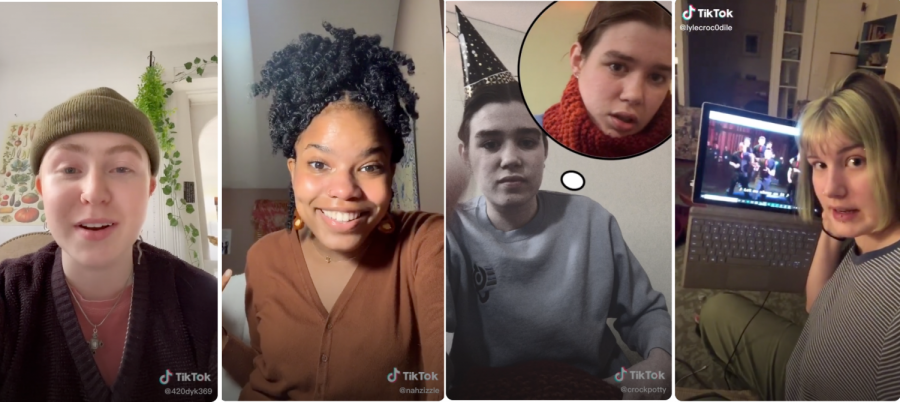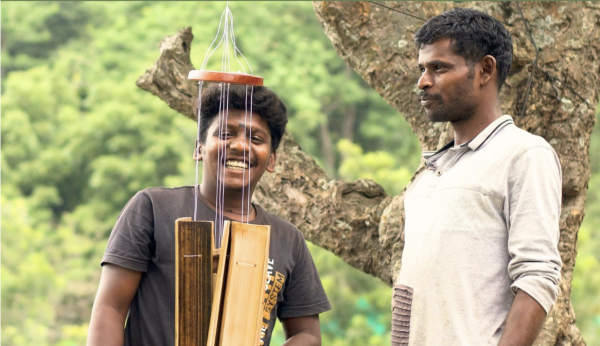Obies Take TikTok
(Left to right) Palmer Lessenberry, Nasirah Fair, Jane Wickline, and Lila Templin are among the Oberlin students who have found notoriety on the popular video-sharing app TikTok.
TikTok, once the height of cringe, has become the hottest place for Gen Z to express themselves online. Obies are well known for their creativity, and so naturally, our campus is populated with a myriad of TikTok creators.
College second-year Lila Templin has been on the app since before it became popular, and they watched TikTok go from embarrassing to trendy in less than a year.
“When I was in high school using it, everyone who had it was like, ‘This is 100 percent a joke,’” Templin said. “I would never take this seriously, blah, blah, blah, blah, blah. … Everything was irony content.”
Templin was first drawn to TikTok because of the demographics they saw there.
“I think it’s the quickest-moving, youngest platform,” Templin said. “Before that, I was mostly on Twitter, which is a lot of professional comedians and older people — which is great, but a very different vibe.”
Templin mostly posts comedic content, including one viral video about a Glee marathon turned nightmare.
“Haters say it’s staged, but I swear on my life it isn’t,” Templin wrote in a message to the Review.
Some Oberlin creators, like College second-year Palmer Lessenberry (@420whor369), use the app to post whatever comes into their heads, from jokes to original music to “thirst traps.”
“I’m definitely very open on TikTok,” Lessenberry said. “I just kind of use it as a finsta at this point.”
College third-year Nasirah Fair, fellow TikTok creator and Lessenberry’s partner, used this openness to her advantage when she and Lessenberry first started dating.
“I didn’t want Palmer to know that I knew they had a TikTok, because they were kind of making TikToks about me at one point,” Fair said. “So I wanted to be able to watch the videos that they made about me for a second … they made a song actually about one of our dates.”
Lessenberry, the TikTok veteran in the pair, gave Fair a couple of tips and tricks to help her get her account off the ground.
“Palmer told me, you just have to go in there and say that you’re gay — it’ll blow up,” Fair said. “And I was like, ‘You’re lying.’ … But I did it anyway, and I tried it. … That TikTok got 13,000 likes.”
Watch on TikTok
College fourth-year Jane Wickline is a comedian and editor-in-chief of Oberlin’s humorous student culture publication The Grape. She uses the app to hone her craft as a comic.
“I try to just do things that I think are stupid and funny,” Wickline said.
One of Wickline’s recurring TikTok bits features her rendition of L.A. Dodgers starting pitcher Clayton Kershaw.
“Most of my feedback from people who have watched this has been very lukewarm, but I just keep making them because I think it’s so funny,” Wickline said. “I just have been doing an impression of like — I call it an impression of Clayton Kershaw, but it’s just a version of Clayton Kershaw that I made up. … I literally googled baseball players, and he had a name that I liked to say.”
Because of TikTok’s powerful algorithm and constant circulation of new content, many creators are able to build an audience quickly.
“TikTok makes the illusion of everyone being famous, which is really interesting because … videos are so short that so many people can be creators,” said Wickline. “Also no one knows how the algorithm works. Your stuff ends up getting shown to people in your extended circle, so it all comes back to you in a way that makes you feel a lot more important than you are.”
While the relative fame of TikTok is titillating, the amount of influence creators are given can have real-world ramifications. Lessenberry’s TikTok account has some very avid followers, many of which are younger queer people who have reached out to Lessenberry via direct messaging, and once an eight-page handwritten letter.
“From what I’ve seen as an outsider, I think people really look up to [Lessenberry] in terms of young people in high school, who are still trying to figure out their sexuality or their gender,” Fair said. “I know that’s a big responsibility.”
Templin also recalled trying to best deal with followers looking for a connection online.
“I definitely have had a lot of people who sent very long Instagram DMs, where people are like, ‘I feel like you would just understand me and we’d be friends, and my life is hard and I really need someone right now,’” Templin said. “I’m always just like, ‘I’m sorry, I am not the person to give you what you’re looking for’ because parasocial relationships are everywhere, and it’s tough on the internet. I feel especially bad because when I was 13, I totally would’ve done the same thing to a YouTuber. I probably did. I don’t remember.”
TikTok’s far-reaching algorithm means certain videos can get a lot of attention, seemingly at random. College fourth-year Shafe Shelvidge (@shafeshack) started making TikToks in part to see if he could go viral.
“I was like, I want to get a bunch of likes on a video,” Selvidge said. “It seems like anyone can do that. Sure enough, anyone can! I am anyone.”











